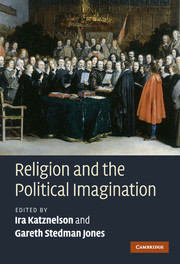Book contents
- Frontmatter
- Contents
- List of contributors
- Acknowledgements
- Introduction: multiple secularities
- 1 Secularisation: religion and the roots of innovation in the political sphere
- 2 Regarding toleration and liberalism: considerations from the Anglo-Jewish experience
- 3 The Enlightenment, the late eighteenth-century revolutions and their aftermath: the ‘secularising’ implications of Protestantism?
- 4 In the lands of the Ottomans: religion and politics
- 5 The Russian Orthodox Church and secularisation
- 6 The American experience of secularisation
- 7 French Catholic political thought from the deconfessionalisation of the state to the recognition of religious freedom
- 8 Religion and the origins of socialism
- 9 From 1848 to Christian Democracy
- 10 The disciplining of the religious conscience in nineteenth-century British politics
- 11 Colonial secularism and Islamism in North India: a relationship of creativity
- 12 The 1960s
- 13 Gendering secularisation: locating women in the transformation of British Christianity in the 1960s
- 14 Does constitutionalisation lead to secularisation?
- 15 Europe's uneasy marriage of secularism and Christianity since 1945 and the challenge of contemporary religious pluralism
- 16 On thick and thin religion: some critical reflections on secularisation theory
- Index
Introduction: multiple secularities
Published online by Cambridge University Press: 05 June 2012
- Frontmatter
- Contents
- List of contributors
- Acknowledgements
- Introduction: multiple secularities
- 1 Secularisation: religion and the roots of innovation in the political sphere
- 2 Regarding toleration and liberalism: considerations from the Anglo-Jewish experience
- 3 The Enlightenment, the late eighteenth-century revolutions and their aftermath: the ‘secularising’ implications of Protestantism?
- 4 In the lands of the Ottomans: religion and politics
- 5 The Russian Orthodox Church and secularisation
- 6 The American experience of secularisation
- 7 French Catholic political thought from the deconfessionalisation of the state to the recognition of religious freedom
- 8 Religion and the origins of socialism
- 9 From 1848 to Christian Democracy
- 10 The disciplining of the religious conscience in nineteenth-century British politics
- 11 Colonial secularism and Islamism in North India: a relationship of creativity
- 12 The 1960s
- 13 Gendering secularisation: locating women in the transformation of British Christianity in the 1960s
- 14 Does constitutionalisation lead to secularisation?
- 15 Europe's uneasy marriage of secularism and Christianity since 1945 and the challenge of contemporary religious pluralism
- 16 On thick and thin religion: some critical reflections on secularisation theory
- Index
Summary
The brilliant sculptor Pietro Torrigiano mutilated a terracotta Pietà he had executed in early sixteenth-century Spain. He was convicted by the Inquisition for defiling a sacred image, and was imprisoned in Seville until he died in 1528. There are moments and places where artists can still be persecuted for violating religious norms. That, for instance, is the situation of Maqbool Fida Husain, a leading nonagenarian and Muslim Indian contemporary painter who lives in Dubai, afraid to return home because of the controversy that surrounds his nude depictions of Hindu goddesses. Think also of the Taliban's wilful destruction of the monumental Buddhas of Bamyan in 2001, said to be idols forbidden by sharia law. But such instances are in the main shocking exceptions.
This book treats religion and the political imagination in the period spanning this transformation. Until quite recently, a rather simple story prevailed. ‘Secularisation’ purported to describe a universal transition from a traditional religious picture of the world to a rational conception. Every society was thought to be caught up in this global trajectory, even if each progressed along it at different speeds. In this approach, the division and differentiation of church and state into separate spheres was identified with a progressive separation of politics from religion, an overall shift from a religious to a rational and scientific mentality, and a waning acceptance of religious authority. This perspective has, for some time, lost its capacity to persuade. And yet, something profound did happen. How should it be understood, studied and analysed?
- Type
- Chapter
- Information
- Religion and the Political Imagination , pp. 1 - 22Publisher: Cambridge University PressPrint publication year: 2010
- 17
- Cited by



